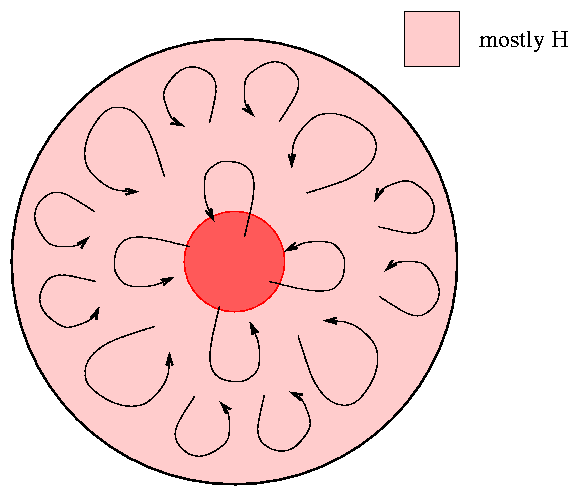
 Copyright © Michael Richmond.
This work is licensed under a Creative Commons License.
Copyright © Michael Richmond.
This work is licensed under a Creative Commons License.
This movie summarizes the evolution of a star like our Sun after it has reached the main sequence.
Today in lecture, I will try to explain what's behind these shifts and countershifts; how the reactions at the center of a star affect its visible outermost layers.
Stars on the main sequence fuse hydrogen to helium in their cores. Since low-mass stars process their hydrogen relatively slowly, they stay on the main sequence for a long time. But what happens when they finally use up all the hydrogen in their cores? The answer turns out to depend on the exact mass of the star: the higher it is, the more violent the end.
Stars which start out with much less mass than the Sun -- around 0.4 solar masses or less -- have a fully convective interior:

Hydrogen fuses to helium only in the central core, but the convective motions mix the helium-rich product throughout the entire interior. At the end of their main-sequence lifetime, they are uniformly helium-rich:
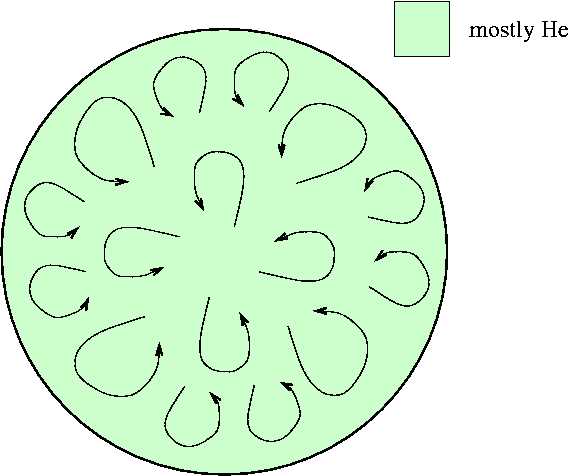
As the star runs lower on hydrogen, the rate at which it generates energy gradually declines. Gravity pulls the outer layers inwards on the core, but the temperatures never rise high enough for any other nuclear reactions to take place. Slowly, gradually, the star becomes fainter, cooler, and smaller. Eventually, it will shrink to a cold ball about the size of the Earth: a black dwarf.
Of course, this is all just speculation. Stars with such small masses take a long, long time to run through all their hydrogen fuel. A star of 0.2 solar masses may take a trillion years to use up all its hydrogen.
current age of universe: approx 15,000,000,000 years red dwarf lifetime: 1,000,000,000,000 years
There hasn't been time yet for a single very low-mass star to use up all its hydrogen, so we can't check to see if our models are correct!
Stars like our Sun differ from their lower-mass brethren in a crucial way: their central cores transfer heat outwards via radiation, rather than by convection.
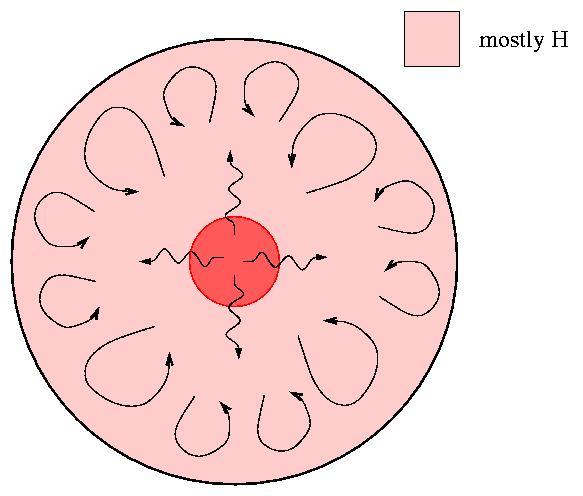
The star evolves slightly on the HR diagram, away from the main sequence.
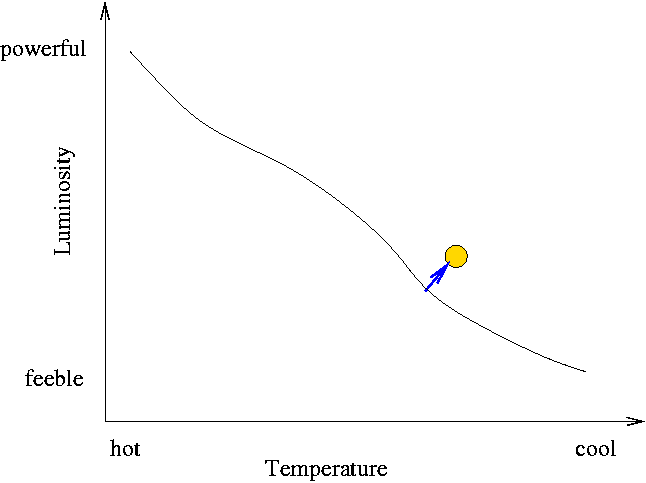
This means that as hydrogen fuses to helium in the core, the resulting helium remains there. As a result, a helium-rich zone builds up in the center of the star, and hydrogen fuses only in a shell around the core:
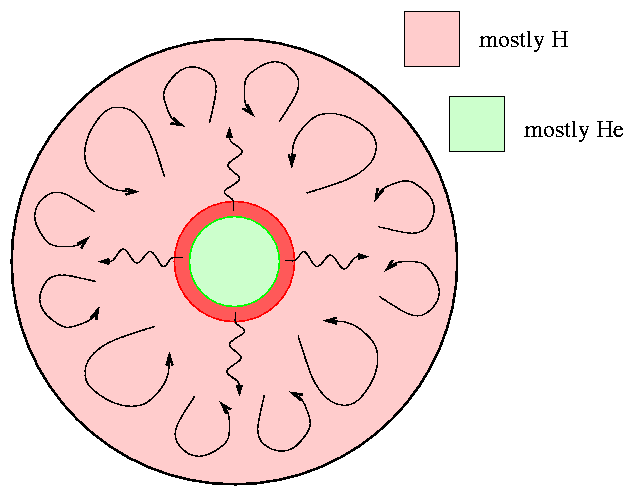
Material in the hydrogen-burning shell is trapped between the outer layers and the inert helium core. Pressure and temperature rise, greatly increasing the rate at which energy is generated. During the shell-burning phase, the extra energy pushes the outer layers of the star very far outwards, increasing the size of the photosphere. As the photosphere moves away from the hot inner regions, it cools off. The star begins to move to the right in the HR diagram.
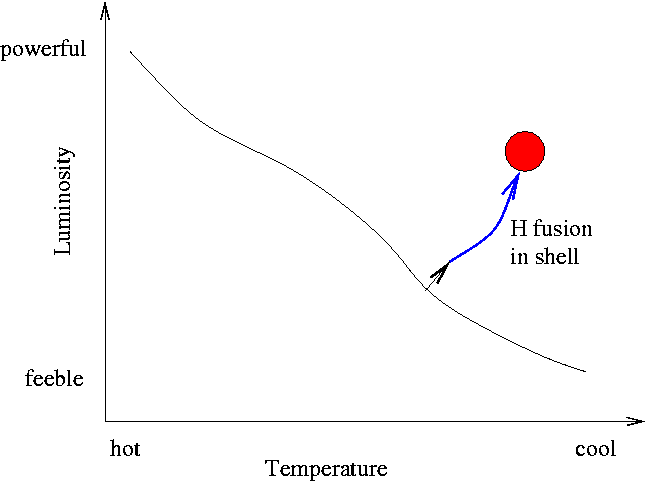
Now, as the hydrogen concentration in the core decreases, and the rate of fusion likewise decreases, the outer layers press inwards due to gravity. The temperature and pressure of the gas in the core rises. Because there's so little hydrogen left in the core, ordinary fusion reactions cannot produce enough energy to push the outer layers back, even at higher temperatures. The stellar thermostat is broken, so the force of gravity pulls the star inwards on the core harder and harder.
Eventually, the temperature reaches a critical point of around 130 million Kelvin (!). Helium nuclei in the core move so rapidly that they are able to overcome their electric repulsion for each other and fuse together in the triple alpha process:

Note that the intermediate product produced in step 1, beryllium-8, is VERY unstable: it will radioactively decay back into two helium-4 nuclei within less than 10^(-16) seconds. In order for a third helium-4 nucleus to smash into the beryllium-8 before it decays, the density of the stellar core must be very high: roughly 7700 times that of water.
The rate of energy generated by the triple-alpha process is even more sensitive to temperature than that of the CNO cycle:
41
rate of energy production = (something) * T
Q: If the temperature in the core of a star
increases by 10%, by how much does the
energy generated by helium fusion increase?
The moment at which the inner core begins to fuse helium to carbon is called the helium flash. After it occurs, the star settles down to a new phase of helium burning. Once again, there is a nice thermostat to regulate the internal properties. The star moves onto a place in the HR diagram sometimes called the horizontal branch.
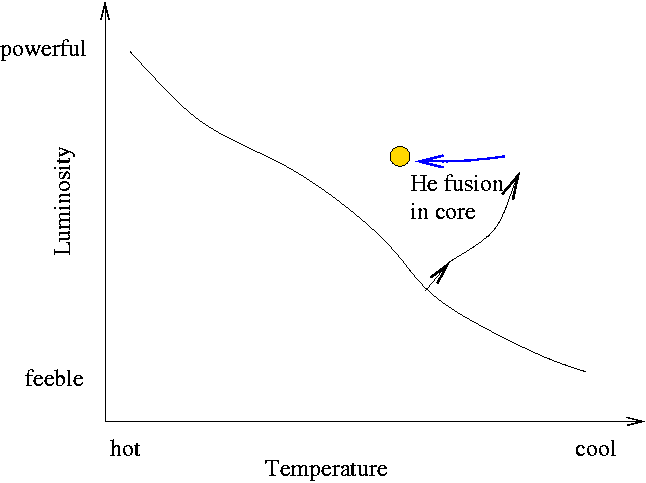
At this point, the star contains
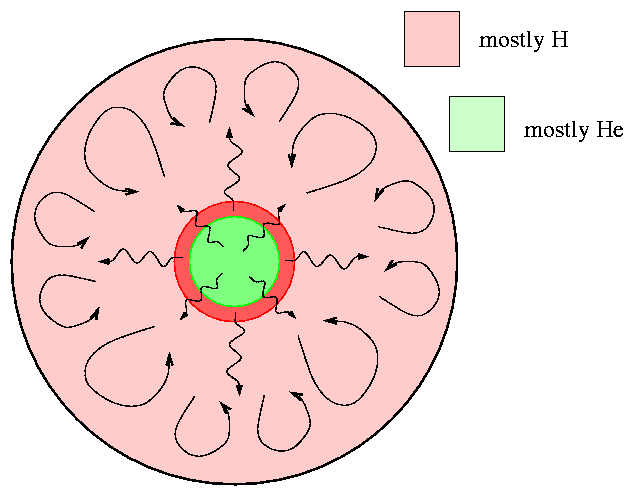
This helium-burning phase of the star's life lasts quite a long time. Not as long as the hydrogen-burning main-sequence phase, for two reasons: first, not all the hydrogen has been turned into helium. Second, the helium-fusing reactions occur at a higher rate than the hydrogen-fusing reactions, due to the higher temperature and pressure of the innermost core. To a very rough approximation, a star fuses helium for about one-tenth the length of its main-sequence lifetime. The Sun, for example, will spend roughly one billion years as a red giant.
As the helium fuses into carbon, the carbon slowly accumulates at the center of the star. Collisions between carbon-12 and a helium nucleus can create the stable nucleus of oxygen-16, which increases with the carbon concentration. Eventually, the helium fusion is restricted to a shell outside a central core of inert carbon and oxygen:
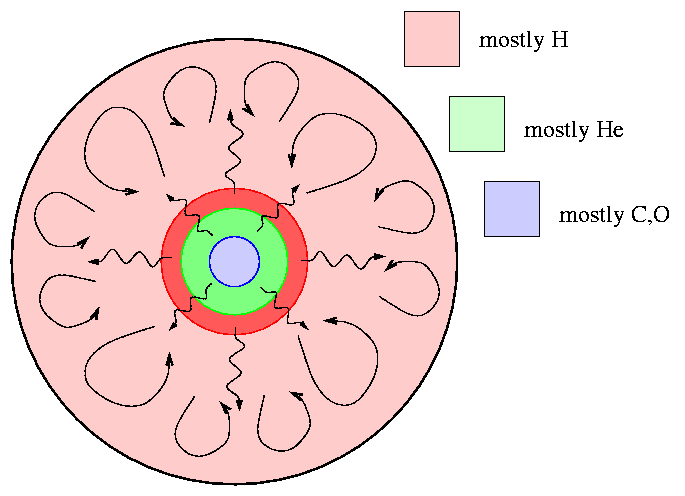
And, once again, during a shell-burning phase, the star moves again up and to the right, along the asymptotic giant branch.
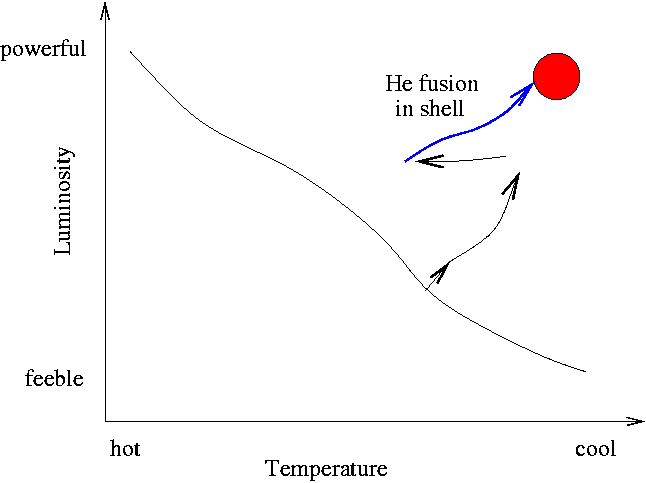
Will the temperatures ever rise high enough to ignite this core of carbon? No, not for stars which start out with less than about 4 solar masses of gas. Instead, the helium- and hydrogen-fusing shells gradually expand outwards. The process isn't always smooth -- the fusion reactions in both shells tend to run in fits and starts. If the hydrogen-fusing shell doesn't fuse quickly enough, for example, then the helium-fusing shell may run low on fuel, and shut down until more helium becomes available. These helium shell flashes can have strong effects on the outer envelope of the star ...
What happens to the outer envelope of a Sun-like star as the inner regions switch from fusing hydrogen to fusing helium? Two things:

When our Sun reaches the red giant stage, its outer layers will expand to swallow the planets Mercury, Venus, and maybe even Earth.

Because the outer layers of a red giant are so far from the star's center, the gravitational force on them is very weak. If the pressure of the radiation from the interior of the star should increase, it can easily shove the photosphere outwards a large distance; or, if the radiation pressure decreases slightly, the outer layers can fall inwards a long way before they reach equilibrium again. Stars in the red giant phase are very often somewhat unstable: their outer layers may pulse outwards and inwards over timescales of days to years.
We can see these pulsations directly: as a star's photosphere changes in radius and in temperature, the amount of visible light it emits varies. Many red giants are long-term variable stars. Some pulse very regularly:
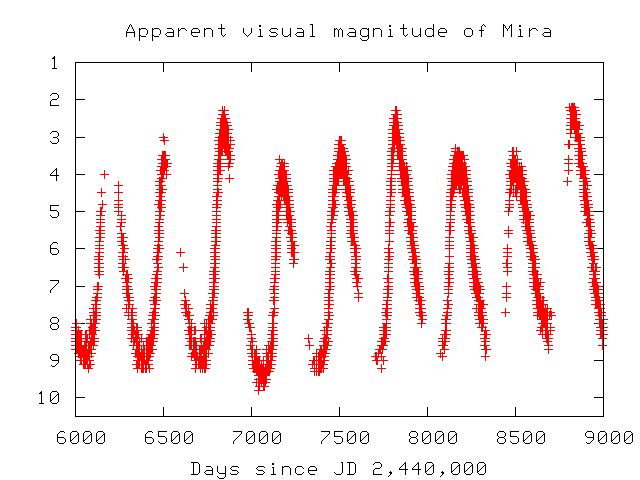
Thanks to the AAVSO for providing this data.
Q: How many months does it take for Mira's brightness
to go through one complete cycle?
Q: How much brighter is Mira at maximum than minimum?
a. about 7 times brighter
b. about 40 times brighter
c. about 630 times brighter
If one particular pulse is especially strong, it may push a portion of the outer envelope outwards so hard that the gas flies off into space and never returns; in other words, it may give the gas a speed beyond the escape velocity of the star. This is one way that red giants may lose some of their mass. Even without sudden pulses, most red giants have very strong stellar winds: flows of atoms, ions and molecules from their outer atmosphere into space. A red giant's wind may carry as much as ten millionths of its mass away into space each year; the Sun's solar wind, by contrast, pushes about one hundred trillionth of its mass away each year.
The consequence of all this mass loss from red giants is the creation a huge shell of material speeding outwards into space around the star. Many stars lose their entire envelope, exposing their hot inner regions.
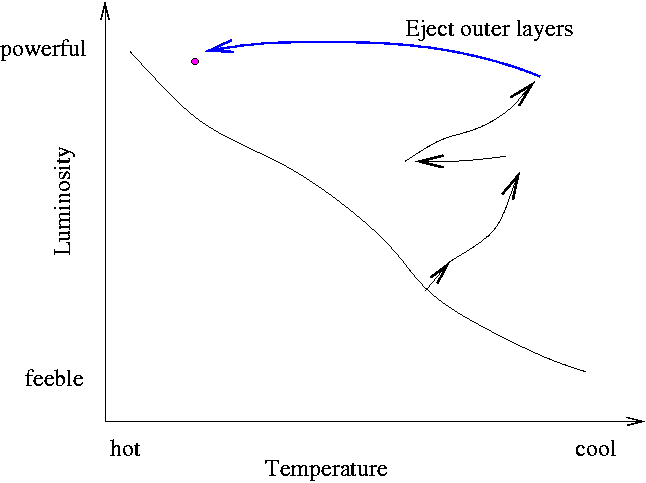
When the ultraviolet light strikes the atoms in the shell, it excites them to high energy states. As the atoms drop back down to lower levels, they emit light as beautiful planetary nebulae.
Q: Why are they called "planetary" nebulae?
Some look like simple spherical shells of gas, such as M57, the Ring Nebula:
But others exhibit traces of complex structure, such as the Cat's-Eye Nebula:
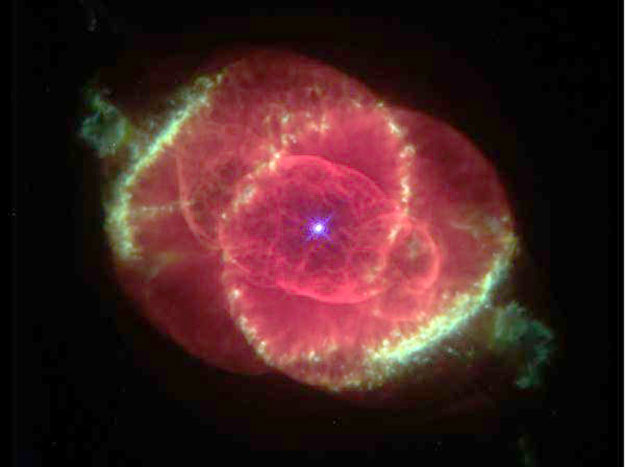
MyCn18,
or the Eskimo Nebula:
It appears that many planetary nebulae have a bipolar structure, in which material flows preferentially in opposite directions from the star:
It's not clear exactly what creates the structure within these glowing clouds of gas. It might be due the effects of stellar rotation on material flowing off the extended envelope. It might be due to magnetic fields. In some cases, it might derive from the orbit of a binary companion around the red giant. At the moment, we just don't understand planetary nebulae.
But that doesn't stop people from doing their best to make models of the procedure. Here are a couple of movies showing simulations of jets coming from an old star blowing bipolar bubbles in its surroundings, created by Vincent Icke.
After it has exhausted the helium in its inner shell, a star has no way to generate more energy: there is no more hydrogen nor helium in its hot, dense central regions. When the pressure of radiation stops flowing outwards, the outer layers of the star (if any are left) fall back inwards. The star shrinks and shrinks upon itself, becoming denser and denser -- but not endlessly. When it reaches a size roughly equal to the Earth's, collisions between electrons in its core provide enough pressure to halt the collapse. The star settles down into a final state of equilibrium as a white dwarf: a very, very dense body, with the mass of a star but the size of a planet.
Q: At its current size, the Sun has about the same overall density as water. When it becomes a white dwarf the size of the Earth, how much denser will it be?
White dwarfs start out very hot, due to the high temperatures of their inner regions. It takes that heat a long time to leak out to the surface and radiate away into space. Because they are so small, white dwarfs emit very little energy, despite their high temperatures. Being very hot, but very feeble, they fall in the lower-left corner of the HR diagram.
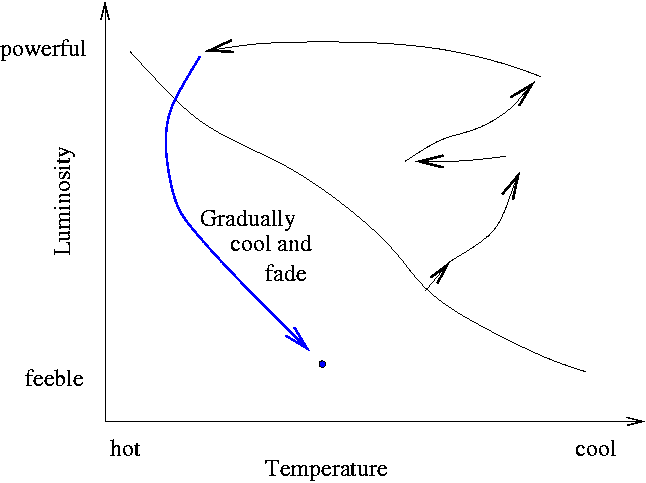
It takes billions of years for white dwarfs to cool, but eventually they do, moving ever down and to the right on the HR diagram. Their fate is to end up as cold, dense, lonely chunks of matter: black dwarfs. Some day, our Sun will join their ranks.
 Copyright © Michael Richmond.
This work is licensed under a Creative Commons License.
Copyright © Michael Richmond.
This work is licensed under a Creative Commons License.